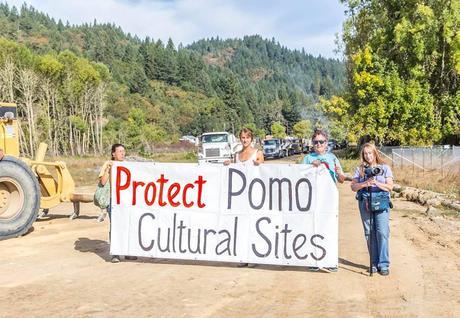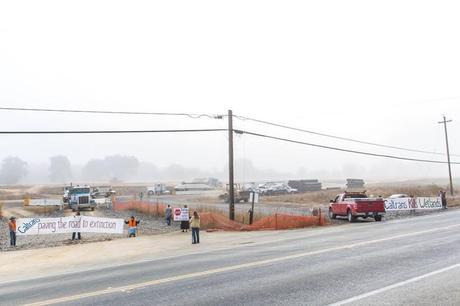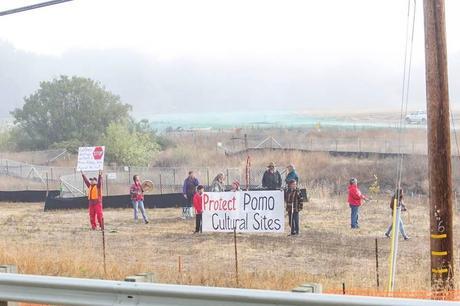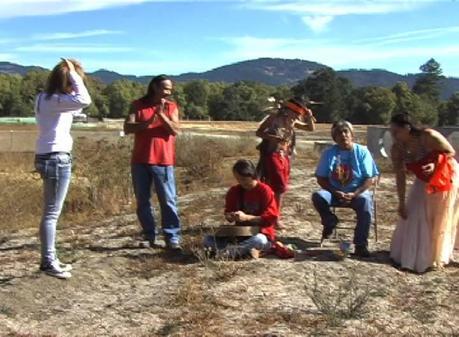from Save Little Lake Valley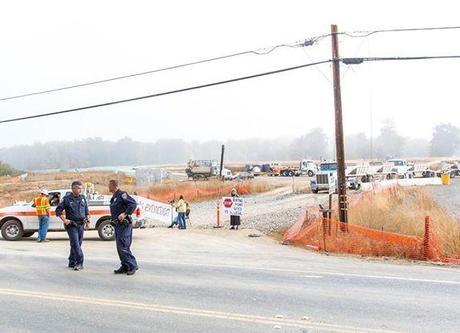
Tribal Pomo Representatives, AIM elders and Environmentalists Block Filling of Wetlands
[Today(9.23) , roughly 30 people blockaded dump trucks at both entrance gates to the Willits Bypass northern interchange construction zone, halting nearly all soil dumping for the day. At roughly 11 a.m., the dump trucks went home for the day. The California Highway Patrol took a light approach to policing the demonstration, making no arrests. We are gathering again tomorrow at 7 a.m. at The Tipi! Only serious rain will prevent us from gathering. Check out the KMUD News report filed by Annie Esposito, which begins at 6:00 into the broadcast.]
Native American Tribal members, including direct descendants of the Pomo peoples who once populated the Little Lake Valley where Caltrans is currently building an oversized freeway Bypass, will join environmental groups in a mass protest on the north end of the project today. Protestors will enter the construction zone north of town in the early morning hours, slowing and stopping the fast and furious flow of dirt-filled, double-belly dump trucks working from dawn to dusk to cover the wetlands and archeological sites the activists seek to protect.
Elders and spiritual leaders from local Pomo Indian Bands and the American Indian Movement (AIM) will lead the way to threatened cultural sites where prayers will be offered for the ancestors. The AIM flag and drum will be present near the construction area where Native American cultural artifacts have been discovered. The sites have been documented and fenced off by Caltrans, but are still slated to be destroyed by being permanently graded and buried under the Bypass as currently designed.
“I hear and feel our ancestors cry to save our villages from destruction. The white man’s history repeats itself. We pray that the Creator will hear our prayers”, said Priscilla Hunter, tribal representative for the Coyote Valley Band of Pomo Indians. “Caltrans placated the interests of local ranchers by giving them permanent grazing rights on the mitigation lands and built the viaduct over the railroad track to preserve it, but yet they don’t listen to the Indians’ concerns for protection of our ancestors’ culture or to our call for downsizing the northern interchange to avoid a large village site.”
The Coyote Valley Tribe requested government to government consultations with the Army Corps of Engineers in June, but to date has received no response. Hunter stated that Caltrans was likely in violation of the Clean Water Act 404 Permit General Condition # 3 which specifically references the protection of archeological sites and Section 106 of the National Historic Preservation Act. At this time, Caltrans has refused to provide any further information about the recent cultural findings to Hunter.
The Coyote Valley Band of Pomo Indians letter to the Army Corps of Engineers and their Resolution for Government to Government consultation can be found here.
Over thirty additional sites and more than one hundred artifacts have been identified since Bypass construction in the valley began. One site is thought to be the ancient village site of Yami. After initially assuring the Sherwood Valley Band of Pomo that construction on this large, known site would be avoided, Caltrans destroyed the village completely in the summer of 2013. Equipment operators did not stop work and did not notify the Tribes, as required. Caltrans admitted the destruction months later, calling it “accidental” and blaming faulty maps. Artifacts in Little Lake Valley are so plentiful it has been described by archeologists as an Archeological District.
Some of the cultural sites being “discovered by bulldozer” are on the so-called mitigation lands, acres Caltrans is relying upon to compensate for environmental damage to public values, called “temporal loss”. When cultural sites are identified, the area is set aside, reducing the acreage available for mitigations. Caltrans needs every acre of scarce mitigation land to make up for the temporal losses already incurred by its chronic failure to perform mitigation measures now two years overdue.
Bypass opponents have proposed a smaller, lower impact design to reduce the amount of mitigation lands needed to satisfy requirements that would also save time money as well as some 30 acres of wetlands while avoiding cultural sites. Caltrans had committed to finding ways to reduce the amount of fill used on the northern interchange as one of the conditions of reinstating its previously suspended 404 Operating Permit under lead agency Army Corps of Engineers. Caltrans has proposed only a minimal 3.5 acre reduction carved from minor design adjustments, without evaluating other, less destructive options.
The Coalition to Save Little Lake Valley and others including Save Our Little Lake Valley, Earth First!, the Willits Environmental Center and Bay Area Coalition for Headwaters are demanding an immediate halt to all fill activities on the northern interchange pending a significant reduction of impacts to protect both wetlands and cultural sites.
9/24 Protesters Come Back!
Despite impending rain, activists returned today for a second day of protest against the bitterly contested Caltrans’ Bypass, after shutting down fill operations on the northern interchange all day yesterday. On Tuesday, two groups of activists held long cloth banners with the messages: ”Caltrans Kills Wetlands” and “Caltrans: Paving the Road to Extinction” stretched across the entrance to two haul roads off highway 101, blocking ingress and egress from the construction zone.
A third group, including Priscilla Hunter, Tribal Representative for the Coyote Valley Band of Pomo Indians and other Native Americans of lineal descent to the area’s Pomo ancestors, succeeded in reaching the ancestral cultural site they want to protect, remaining there for some time with the American Indian Movement (AIM) flag, to drum and pray. The activists then blocked a third stream of dirt-filled trucks, effectively stopping work.
Protesters’ numbers have increased lately due to the participation of Native American Pomo Tribes, including those from Coyote Valley, Sherwood Rancheria, Potter and Redwood Valley, all of whom were represented at the protest.
There were no arrests on Tuesday. CHP officers were present in one squad car and one van, but did not tell protesters they were trespassing and did not ask them to leave, as erroneously stated by Caltrans Public Relations official, Phil Frisbee in the Santa Rosa Press Democrat on Tues. Sept. 23.
“We came back again today to insist on our demand for a less destructive, less expensive design for the northern interchange to protect cultural sites and wetlands”, said Naomi Wagner of Redwood Nation Earth First!
